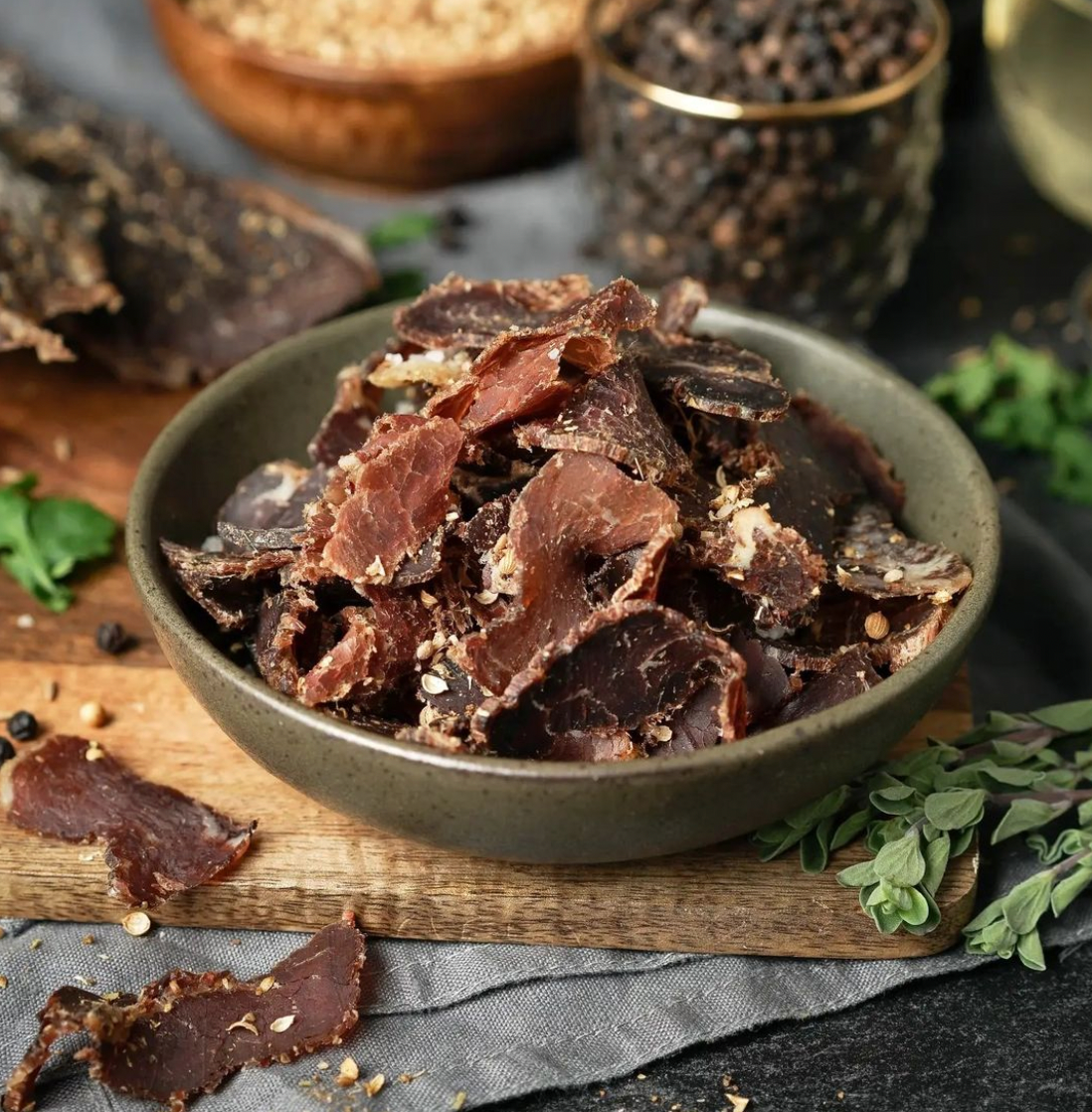What is biltong
Biltong is a form of dried, cured meat that originated in South Africa and is becoming more popular here in North America. The word biltong comes from the Dutch word bil meaning “rump” and tong meaning “strip” or “tongue”.
It’s similar to beef jerky in composition, although the taste, nutritional profile and production processes are much different. Made with marbled steak and whole spices, it tastes like a steak, has the texture of a fine prosciutto, is high in protein and free from sugar, carbs, or anything artificial.
How is biltong made?
The distinctive flavor of biltong is attained by coating slabs of steak with rock salt, ground black pepper, and vinegar before it is hung out to dry. Optional spices with the added benefits of their natural preservative qualities like ground coriander seeds and allspice are also added before the drying process starts.
The air-drying process is achieved by hanging the biltong in a cool, well-ventilated place for ten to fourteen days. Depending on the desired dryness, the biltong will shrink to about half its size and become a rich maroon color.
Fresh biltong should be enjoyed within four days if a moisture-rich consistency is preferred. When properly packed, biltong can last for a few months. Made from superior cuts of meat and natural spices, it tastes just like a delicious, aged steak.
Where did biltong originate?
Biltong originates from South Africa. Back in the day, Dutch pioneers migrated to the interior of the Southern tip of Africa, in an effort to avoid British rule in Cape Colony of South Africa. This migration is known as the Great Trek. Thousands of Duch farmers called Voortrekkers needed to carry preserved food supplies with them to survive the long, challenging trek through the African bush teeming with predators and, luckily for the Voortrekkers, abundant sources of wildlife to make biltong.
These 17th century European settlers had no refrigerators and freezers, of course. Still, they found a way to preserve meat with salt, vinegar, and saltpeter (potassium nitrate) and hang it out to dry during cooler weather.
Biltong was the perfect solution for this long journey. It was high in protein, portable, non-perishable, and highly nourishing.
What meat is biltong made from?
Although various meat types like chicken, fish, and venison can be used, the most popular meat is beef. Being relatively new on the international market, the process of making biltong is still true to tradition. Untouched by commercial processes, biltong sold in the USA is typically made using grass-fed beef without artificial flavors or preservatives.
What's the difference between biltong and beef jerky?
Biltong is a bit like beef jerky but with a significant difference in taste.
Even before you put a piece of biltong in your mouth, you will notice the difference in texture. Although beef is most commonly used in both biltong and jerky, the beef used in biltong is generally much thicker due to the cut of the meat and slower drying time. Typically slabs of steak are cut into strips that are one inch wide – sometimes thicker – whereas jerky is normally very thin. Also, depending on the dryness of biltong, it can be fibrous or melt-in-your-mouth soft like prosciutto, whereas jerky is typically soft and chewy.
The most notable taste difference is the decadent meaty flavor of biltong, reminding most people of a prime-cut aged steak. Beef jerky on the other hand, is often has a dry and smoky taste, (jerky is often smoked, while biltong is never smoked) biltong offers a unique meat flavor.
Biltong also has zero sugar, no artificial flavors or preservatives, whereas beef jerky typically has high amounts of sugar, nitrates and flavors added.
What are the different types of biltong?
There is a perfect bite for every biltong connoisseur. Firstly, you have a choice between a slab of biltong or precut slices of biltong. The slabs of biltong are reminders that biltong is made from choice cuts of whole beef and nothing else. Slabs of biltong are sliced right before eating it. Many South African kids can relay fond memories of their grandparents slicing biltong with a pocketknife and sharing it out around a kitchen table or campfire.
Sliced biltong is a handy, quick snack. The sliced biltong is made in small batches, and vacuum sealed, ensuring freshness. Biltong bites are made when biltong is sliced with the grain into finger-length strips.
When is the best time to eat biltong?
Because of its nutritional profile, biltong is the perfect high-protein, no-carb snack for road trips, hiking, after the gym, the office or even late at night. It’s an easy way to eat healthy on the go.
In saying that, many of our customers absolutely love it and find themselves pairing it with their favorite craft beer, regularly adding it to their salads, sandwiches and charcuterie boards.
Is biltong good for you?
If you are looking for a zero sugar, low carbohydrate, a high protein snack, biltong is an excellent choice. Biltong is pure beef and contains all nine essential amino acids. One serving of biltong provides a large portion of your daily protein requirements and is packed with micro-nutrients including iron, zinc, B12, B6, and selenium. All these nutrients are preserved because of the no-heat slow curing process.
This nutritious food helps build muscle, repair tissue, boost immunity and promote brain and body functions. It is deliciously good, healthier than most protein bars, and more satisfying than a bag of potato chips. Since it is naturally low carb, low sugar, and completely gluten-free, biltong is recommended for paleo, Keto, and Whole 30 diets. There is a tasty choice of nutrient dense deliciousness for you to sink your teeth into, no matter your flavor preference.
